The Toyota Rush was released in the Philippines back in 2018. Since then, it has garnered a reputation for being a reliable family car. For those who are familiar with Toyota models, that comes as no surprise though since this MPV is actually based on the already proven Avanza.

The Toyota Rush seven-seater MPV
However, as time marches on (and depending on how you use it), the Rush will eventually encounter some issues. No, these aren’t common at all, but sometimes, even the most robust cars will experience wear and tear. So, what are the most common Toyota Rush problems, and how does one fix them?
Common Toyota Rush Problems
Toyota Rush Engine Problems – First and foremost, be aware that the Rush uses the 1.5-liter 2NR-VE. It is an upgraded version of the 1NR engine, which replaced the older 2NZ-FE. That said, it had inherited some of the older engine’s usual issues. Do note that these commonly occur at very high mileage points, specifically from 150,000 km to 200,000 km on the odometer.
One such issue is high oil consumption. This commonly occurs somewhere with around 150k on the Rush’s odometer. When this happens, you’ll need to replace its piston rings and valve stem seals. For that matter, one should also check for crankshaft oil leaks and loss of oil pressure. Although, this particular issue doesn’t usually happen until around 200,000 km on the odometer.
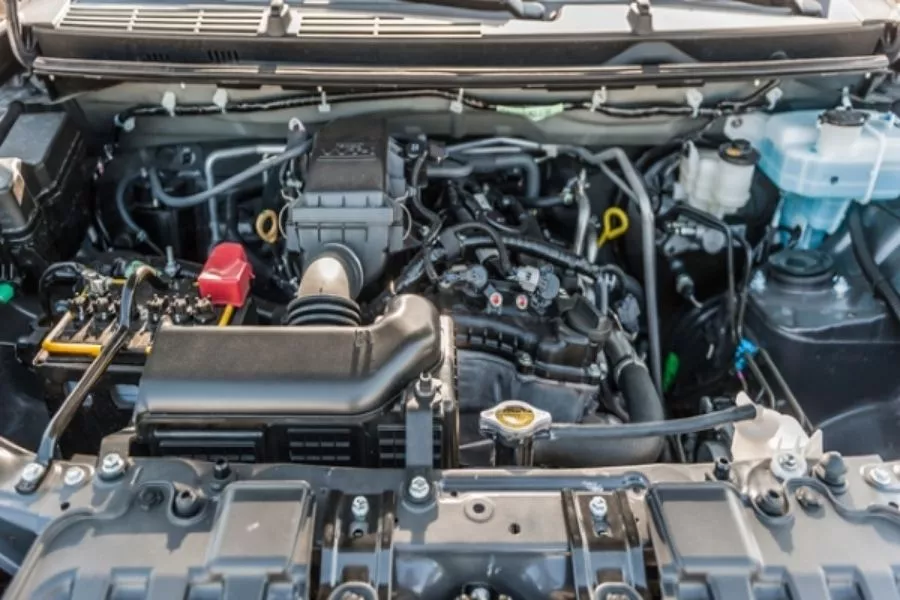
The Rush's 1.5-liter 2NR-VE
Also typical is a problem with the Toyota Rush’s alternator belts. This commonly manifests as whistling noises, but it can be simply fixed by replacing the potentially worn-out alternator belt.
Next up is engine vibrations. That’s because its engine mounts are usually made out of rubber, which we all know will wear out in time. The only way to fix this is to replace the said engine mount in the casa.
Toyota Rush gearbox problems – While Rush gearbox problems do occur, they’re not as common as one would think. Due to wear and tear though, these usually manifest as slipping and shuddering when trying to change gears.
To fix this, one has to first check your Rush’s automatic fluid levels. If the fluid is too low, it might cause the said problem. Also, accidentally putting in the wrong fluid can cause the same issues. So do be careful with that.
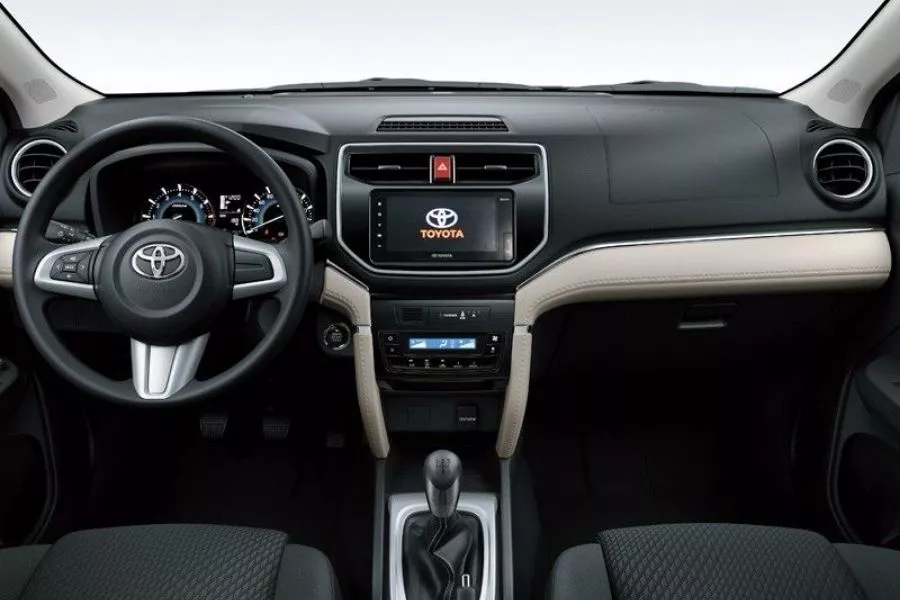
Do note that the Rush also has a manual version
On very high mileage units, one should also be aware of torque converter seal damage. This might cause transmission fluid leaks, which will then cause the issues stated above. If you suspect a leak though, one might need the help of a mechanic as this fix needs major disassembly of the transmission system.
Toyota Rush aircon problems – Aircon problems on the Rush are usually presented as stinky air. This is fixed simply by replacing the cabin air filter. As a precaution, we recommend doing this every 32,000 km.
Another possible issue with the Rush’s aircon is a dirty condenser or dirty evaporator. If the former is dirty, one may experience poor cooling. If it’s the evaporator that’s dirty, then the air coming from the AC might be spewed out in intermittent gusts or come with a bad smell.
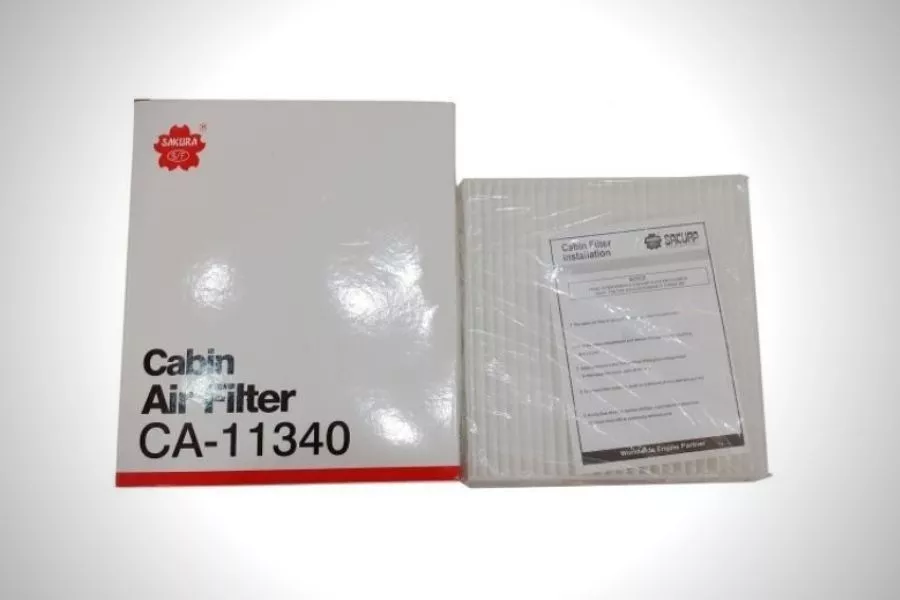
Aftermarket cabin filters are cheap and easily found
For the evaporator, one can simply remove the front bumper, and spray the condenser with low-pressure water. For the evaporator however, cleaning it will involve the removal of the dashboard. As such, one might need the help of an automotive aircon specialist.
As mentioned in the introduction, the Rush is known to be a robust vehicle. The issues stated above usually occur far into the said car’s lifetime, and most are easily preventable with regular checkups and maintenance.
For more tips on basic car repair, keep it here on Philkotse.com.
Know more about Toyota Rush 2025

The Toyota Rush 2025 is Toyota Motor Philippines (TMP)’s entry into the local competitive multi-purpose vehicle (MPV) segment. Considering its relatively large size and affordable pricing, the MPV is regarded by some as an entry-level SUV for the Japanese car brand. Toyota Rush Price in the Philippines is P1,208,000 with only one 1.5 G-RS variant. Under the hood, it is powered by a 1.5-liter 2NR-VE inline-4 DOHC gasoline engine that makes 102 hp and 134 Nm of torque. This engine can be connected to a 4-speed automatic transmission. Dimensions-wise, the Rush spans 4,435 mm in length, 1,695 mm in width, and 1,705 mm in height. In the local market, this vehicle from Toyota Philippines competes against the likes of the Mitsubishi Xpander and Honda BR-V.
There are many SUV-like features that the Toyota Rush offers such as a relatively high ground clearance rated at 220 mm and its new seating configuration that makes seven as standard across all variants. It is considered one of the best value for money, especially for those who wish for a relatively affordable family car. In other markets, the Toyota Rush is called the Daihatsu Terios due to the Japanese automaker's partnership with Daihatsu Motor.
>>> New and used Toyota Rush 2025 for sale in the Philippines
Toyota Rush Launch
The updated Toyota Rush was introduced by TMP last November 2020 which now offers a 7-seating configuration as standard. The Japanese carmaker shared that a 7-seater MPV is a favorite family vehicle among Filipinos so it wanted to add a third row of seating for all variants.
In 2022, TMP replaced the top-spec Rush G with the sportier GR-S variant. The updated 7-seater MPV is currently competing against the likes of the Mitsubishi Xpander, Honda BR-V, and Maxus G50.
Toyota Rush Exterior
The Toyota Rush is currently riding on the exterior design of the third-generation Daihatsu Terios. It comes with an SUV-like and more aggressive road presence as it is inspired by the design of its 7-seater midsize SUV sibling, the Toyota Fortuner.
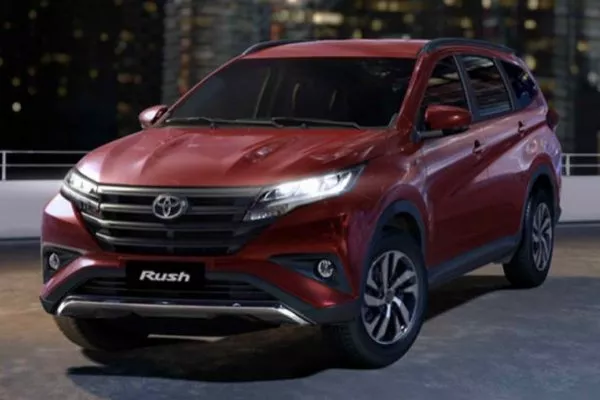
The exterior design of the Toyota Rush is inspired by the Toyota Fortuner
All variants of the Toyota MPV are installed with LED headlights and taillights (with LED guidelines), a rear spoiler, a shark-fin antenna, and more. E variants get chrome radiator grille and 16-inch alloy wheels, while the top-ranging GR-S variant comes with GR-S treatment and 17-inch alloy wheels.
Toyota offers the Rush six color options: White, Bronze Mica Metallic, Dark Red Mica Metallic, Bordeaux Mica, Silver Mica Metallic, and Black Metallic.
Toyota Rush Interior
As said earlier, all variants now come with a 7-seating configuration which should be practical for those who want to own a relatively large car but don’t want to spend a hefty amount of cash. The 50:50 third-row seats can be folded to offer more cargo space.
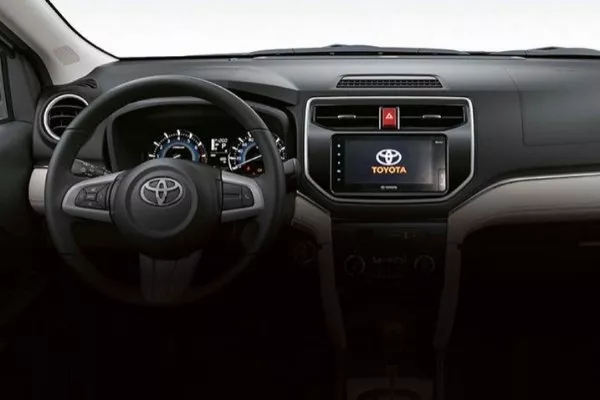
Another notable feature inside the Toyota Rush is the white accents on the doors and dashboard decorated with faux stitches
The interior for the lower E variants is installed with a urethane 3-spoke steering wheel, shift lever, and knob. Meanwhile, the top-ranging GR-S variant benefits from leather materials on the said interior parts and three accessory outlets as compared to just one for E variants.
>>> Get best deals of the Toyota Rush for sale in the Philippines at amazing prices
Technology & Safety Features
The Toyota Rush is installed with a 7-inch infotainment screen across all variants which supports CD/MP3, AUX, USB, Bluetooth, and Weblink Connectivity for iOS/Android. Sounds are sent off to six speakers for E variants, while the top-of-the-line variant gets eight.

Toyota Rush's airbags
As for safety, the updated model still offers the same features such as six airbags, an anti-lock braking system (ABS) with electronic brakeforce distribution (EBD), traction control, hill start assist, emergency stop signal, and ISOFIX tethers. Keyless entry is used for E variants and smart entry is the go-to for the GR-S variant.
Platform & Chassis
The Toyota Rush is designed with a ladder-frame chassis similar to the Toyota Avanza. It is built on the Daihatsu F800, the platform of the current Daihatsu Terios. This platform configuration, including the 220 mm ground clearance, solidifies the model’s reputation as a small yet rugged SUV.
To further improve stiffness, the front suspension is handled by a McPherson Strut, and a four-link suspension for the rear setup. As for the brakes, the 7-seater MPV is installed with disc brakes on the front wheels and drum brakes for the rear wheels.
Engine & Drivetrain
Under the hood, the Toyota Rush is powered by a 1.5-liter 2NR-VE Dual VVT-i gasoline engine that can put up 102 hp and 134 Nm of torque. This is the same engine that the Toyota Avanza and Veloz use.

Powering the Toyota Rush is a 1.5-liter 2NR-VE Dual VVT-I gasoline engine
For the base E variant, it pairs the engine with a 5-speed manual transmission. Meanwhile, the rest of the two variants of the model use a 4-speed automatic transmission. The power is sent to the rear wheels thanks to its rear-wheel-drive (RWD) drivetrain.
>>> Also check out:
- What we'd like to see from an updated Toyota Rush 2020 Philippines
- Sib Duel: Toyota Rush vs Innova MPV Specs Comparison
Toyota Rush 2025 Price List
| Variant | Price |
|---|---|
| Toyota Rush 1.5 GR-S | ₱1,208,000 |
Toyota Rush FAQs
1. Does Toyota Rush Philippines have cruise control?
No, it doesn't. No variants of the Rush come with cruise control.
2. How much will the Toyota Rush 2025?
The Toyota Rush is priced at P1,202,000.
3. What engine will the Toyota Rush 2025 use?
Toyota Rush is operated by a gasoline engine (1.5L) with a maximum output of 102 horsepower and 134 Nm.
4. What is the length of the Toyota Rush Philippines?
The length of the Toyota Rush is 4335mm, while the width is 1695mm.
5. Is the Toyota Rush a reliable car?
Yes, it absolutely is. The Toyota Rush is one of the best-selling SUVs in the Philippines market because it offers a perfect combination of performance, style, and comfort.
₱ 1,012,000 - ₱ 1,176,000
ExploreRecent posts
- seven seater vehicles philippines May 11, 2021
- Latest Toyota Rush Price Philippines 2025 Sep 23, 2025
- Toyota Philippines price List 2025 May 10, 2023
















